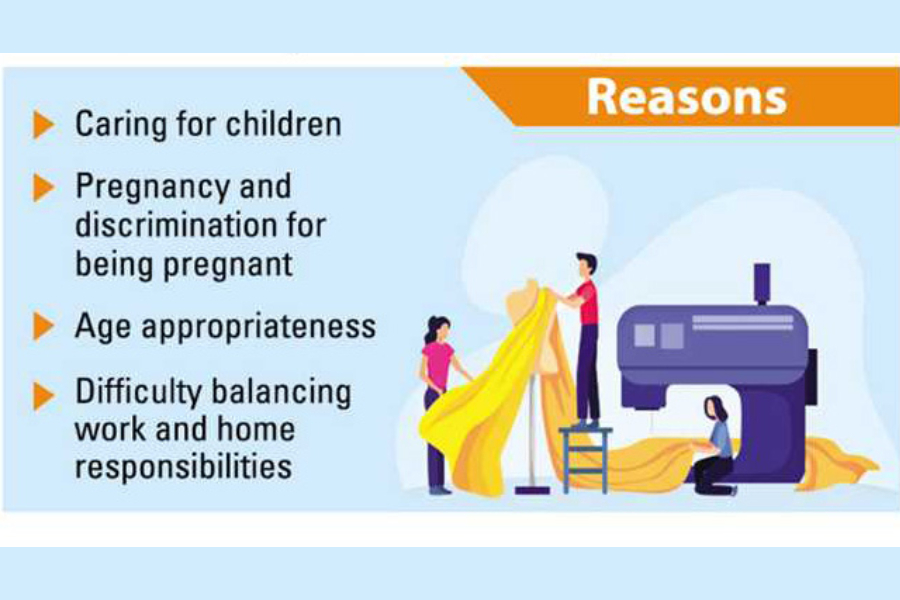Women workers' ratio in RMG industry on decline
Latest report finds that share of women workers in 2021 was 53.65pc, which was 80pc in the 1980s

Published :
Updated :

The proportion of women workers in the country's readymade garment (RMG) industry continued to decline and stood at approximately 54 per cent in 2021, according to a latest report.
Caring for children was cited as the main reason for leaving the garment industry followed by pregnancy and discrimination for being pregnant, age appropriateness, difficulty in balancing work and home responsibilities and working conditions including harassment, violence, long working hours and low salaries.
The changes also have significant implications on women's economic empowerment and the well-being of their families and communities, stated the report, titled 'The declining women workers in the Bangladesh RMG industry'.
The Ethical Trading Initiative (ETI), GIZ and Brac University jointly conducted the research, funded by the Sustainable Textile Initiative: Together for Change (STITCH) and supported by the Ministry of Foreign Affairs of the Netherlands.
The report looked at entry into and exit from the RMG industry, the reasons both for entry and exit by women garment workers and the implications of these changes for women's participation in the US$42 billion RMG sector.
A total of 337 factories, 370 current women garment workers, 285 former women garment workers and 183 potential women workers were surveyed while nine focus groups with 89 participants and 16 key informant interviews with key stakeholders, including buyers and suppliers, were made.
When asked, lead author of the study, Dr Shahidur Rahman, Professor of the Department of Economics and Social Sciences at Brac University, said the report cited different surveys that used various methodologies to collect data, but there has been a different figure on the share of women workers in the RMG industry.
However, a trend of declining women's proportion in this sector is evident - a significant decline compared to the proportion during the time of the inception of the RMG industry in Bangladesh, he noted.
He, however, said they identified the reasons why women numbers in the RMG sector have been declining and their impacts, and found that the family condition is one of the major reasons behind the decline.
Bangladesh Garment Manufacturers and Exporters Association (BGMEA), consistently from 1980 to 1994, reported that the proportion of women labour had been 80 per cent. However, in 1995, it fell to 76 per cent and further fell to 70 per cent in 2005.
According to separate UN Women reports, the proportion of women garment workers was 63.4 per cent in 2010 and 60.5 per cent in 2018.
A CPD (Center for Policy Dialogue) study found that the proportion fell to 58.4 per cent and 53.2 per cent in 2012 and 2016, respectively.
In 2017, however, SANEM reported that the proportion rose to 61.17 per cent.
In contrast, the data published by Farole et al. show that the proportion rose by a smaller margin to 54 per cent.
"In 2020, according to Mapped in Bangladesh (MiB), it was 58 per cent while this project finds that the proportion of women garment workers was 53.65 per cent in 2021," according to the ETI report.
The report stated that this is a significant decline compared to the 1980s when 80 per cent of the workers in the sector were women.
Among workers who left the RMG sector in 2021, 51 per cent were women compared to 49 per cent in 2015. This shows a slight increase in exit numbers.
An overwhelming majority of the workers or 89 per cent who left the sector responded that their departure was voluntary in that their contracts were not terminated by factory management.
"Some 77 per cent of reasons cited by the former workers were related to a family condition like caring for children (26.67 per cent), pregnancy (17.89 per cent), and age appropriateness (11.93 per cent)."
On the other hand, 19.29 per cent of the reasons cited by former workers were related to working conditions such as workload, long working hours, and low salaries, according to the report.
Negative working conditions increase the probability of leaving garment factories by 15.95 per cent, it showed. Focus group participants, however, noted that factories put excess pressure on workers by requiring them to produce upwards of 180 to 200 units every hour.
According to the report, a worker can typically produce an output of 100 to 120 units in an average workday.
It found that 8.0 per cent of all current women workers wanted to leave the RMG sector after one year and 27 per cent after five years.
Female workers are 15 per cent more likely to leave garment work in the long run if they experience any harassment, it said.
The report also found that upward mobility is extremely limited for women garment workers.
About 86 per cent of workers joined the factory as helpers, 66 per cent left as operators and only 1.0 per cent as supervisors. However, this was not cited by participants as a reason for leaving the industry.
The implications of this decline are identified by the report included reduced income, impacts on social networks, agency and worker voice for women.
The decline also has an impact on advancing gender equality and women's economic empowerment, according to the report.
The report made a number of recommendations for factories that included creating a healthy work environment, reducing demands for overtime, ensuring regular payments and providing facilities for childcare and healthcare.
For brands and buyers, its recommendations included reviewing purchasing practices, implementing effective gender-sensitive human rights due diligence, and investing in programmes to support factories that do not discriminate against women.
The report also recommended that the Bangladesh government review legal frameworks and policies and convene stakeholders to collectively address issues.
Munni_fe@yahoo.com


 For all latest news, follow The Financial Express Google News channel.
For all latest news, follow The Financial Express Google News channel.